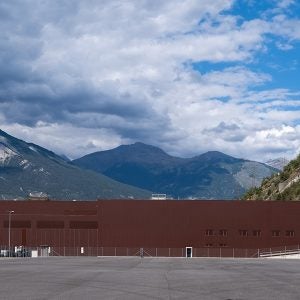
Catherine Anderson from AECOM discusses the potential scope and future prospects for pumped storage.
Pumped storage hydropower schemes are one of the unknown wonders of the energy industry. Technologically well proven, this cycle of pumping, storing and generating provides a flexible and valuable balancing service to the National Grid in the UK.
Some schemes are operated to help balance peak loads but others are used as a short term operating reserve, providing a fast response to short-term rapid changes in power demand or sudden loss of power stations.
One of the key features for the future of pumped storage is in parallel to the increase of renewables; as the capacity of renewable energy increases, the need for balancing plants such as pumped storage becomes stronger. Indeed, matching consumer demand when there is increasing reliance on intermittent renewable energy, such as windfarms, means that the energy can be effectively stored with pumped storage schemes – making them perfect partners.
Pioneering pumped storage projects in the UK
Most schemes in the UK are located in Wales and Scotland. The most well known is Dinorwig, located in Snowdonia National Park in North Wales, which is the largest scheme of its kind in Europe (at 1728MW) and has become a very popular tourist attraction known as Electric Mountain. Construction began in 1974 and it took ten years to complete. Estimated at £425M it was the largest civil engineering contract ever awarded by the UK government at the time. The build involved the removal of 12M tonnes of rock from within the Elidir Mountain in order to construct 6km of underground tunnels and an enormous cavern 51m tall, 180m long, and 23m wide to house the turbine hall. With all generating units operating the scheme can go to full generating capacity in approximately 16 seconds, and once running, the station can provide power for up to six hours before running out of water.
Other notable schemes in the UK include Ffestiniog Power Station (also in North Wales) which was the first ever built in the UK in 1963 and is capable of generating up to 360MW. In addition Cruachan (400MW) on the shores of Loch Awe in Argyll & Bute in Scotland was the world’s first reversible high head pumped storage hydropower scheme.
In terms of the future for pumped storage developments in the UK, the 49MW Glyn Rhonwy scheme developed by Quarry Battery Company, was the first pumped storage scheme to be granted permission in England and Wales in 30 years. AECOM was the principal engineering and environmental consultant on the scheme and supported Quarry Battery Company through the preliminary design, EIA, and planning process. The scheme was successfully awarded planning permission in September 2013.
Elsewhere Iberdrola/Scottish Power is currently undertaking studies to investigate the potential to increase the size of the underground reservoir at Cruachan which could increase the capacity of the scheme to 1040MW. Scottish and Southern Energy (SSE) is looking to convert the conventional hydroelectric scheme at Sloy on the shore of Loch Lomond into a pumped storage scheme. Furthermore SSE has recently gained planning consents for a scheme at Coire Glas (300 – 600MW) on the shore of Loch Lochy, and is developing a scheme at Balmacaan (300 – 600MW) on the shores of Loch Ness.
The application of pumped storage in other parts of the world can be much larger. Bath County in the US is the largest pumped storage scheme in the world at 3003MW and there are two plants located in China each with an installed capacity of 2400MW.
Fitting in with the environment
Schemes in the UK are cleverly landscaped and make best use of their surrounding environment and topography. The penstocks and turbine hall at Dinorwig were constructed within the mountain, and the headpond, which has recently been extended, is inconspicuous in the surrounding environment.
Consideration had to be given the Arctic Char present in Llyn Peris (the water body used as the tailpond), which required the construction of a 3km diversion of the watercourse around the tailpond to enable unimpeded passage during the Char’s migration. By contrast, the Glyn Rhonwy scheme is unique as it uses existing but redundant slate quarries for both headpond and tailpond.
The main factors used to identify suitable sites are the level of head (i.e. the difference in height between the upper and lower reservoirs); the distance over which this is achieved; the right topography (redundant quarries and deep valleys which can be dammed being preferable); and the existence of proximate or connected water bodies. Therefore, the locations of existing schemes within the UK are primarily based on topography and landscape features and whether the engineering practicalities are possible. The Dinorwig, Ffestiniog and Sloy schemes are all located within National Parks. The existing Sloy scheme has a number of Grade I listed buildings on it and Glyn Rhonwy is located within an historic landscape. These are therefore excellent examples of how energy schemes can work within designated areas and complement the existing environmental and social landscape.
Coastal schemes
Pumped storage technology has evolved to coastal schemes using seawater. Coastal projects uses the same principals as traditional schemes but the sea is the tailpond and therefore has to be specifically engineered to cope with these conditions. At Okinawa Island on the north eastern coast of Japan, the headpond is lined to avoid sea water leakage and contains secondary drainage and pumps combined with detectors to alert operators of suspected leaks. It uses fibreglass reinforced plastic for the penstock and the turbine is made from austenite stainless steel to minimise corrosion from the seawater and also to minimise adhesion to the equipment by marine creatures. Furthermore, the discharge outlet is located in an area with the least coral development and a breakwater was created to limit the discharge velocity to approximately 10cm/sec to help protect the marine environment.
Defining factor: economics
Whilst environmental constraints are obviously important to the feasibility of pumped storage schemes, commerciality is the defining factor. The economics for pumped storage can be long term and complex and there is not currently an "off the shelf" cost model which is able to assess the feasibility of proposed schemes, although AECOM and Quarry Battery Company are currently developing one in conjunction with DECC. In addition, they are considered large capital investments and generally the development cannot be staged. The cost of building the Glyn Rhonwy scheme is expected to be in the region of £120M with the press reporting the cost of the proposed Cruachan extension to be in the region of £1B. It is also estimated that sea water schemes generally cost 20% more than traditional schemes due to the mitigation measures needed due to the use of sea water. However, given Iberdrola has just completed a £1B extension to the La Muela pumped storage scheme in Valencia, Spain after a seven year construction period, there is obviously some appetite for such a construction and engineering feat.
Another key element for the future is balance – the difference between off peak and peak energy prices and how this can influence the requirement for larger schemes against the utilisation of a series of smaller schemes.
Finally, the growth in the potential has been equalled in part by the requirement for political support. Scottish planning policy has already recognised the potential for an expansion in pumped storage facilities within the draft National Planning Framework.
The number of operational and consented pumped storage schemes currently located in the UK is a clear indication that these schemes are possible within challenging environmental constraints. The relatively flexible deployment, together with the proven technology at its heart, whether traditional or sea water, can unlock both UK and worldwide potential, especially where energy generation, energy security and balancing potential are limited. It is also apparent that pumped storage is seen as a key companion to the increasing capacity of renewable energy schemes, such as windfarms, across the UK. Therefore, just as windfarm schemes are allocated within planning policy, so should pumped storage (although it is recognised that not all parts of the UK lend themselves to the topographical requirements of a pumped storage scheme). With that in mind, a key function of pumped storage is to balance the grid. Is location really an issue or does more need to be investigated into the benefit of having a fewer number of larger schemes or a series of smaller more localised schemes? Regardless of the size or location, the increase in awareness and recognition that it plays an important part in regulating the energy supply within the UK will no doubt make the energy, engineering and hydropower industry get increasingly excited over what feasible schemes will be brought forward.
Author information
Catherine Anderson is the Associate Director of AECOM and EIA Project Manager for the Glyn Rhonwy PSH






